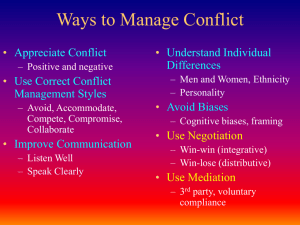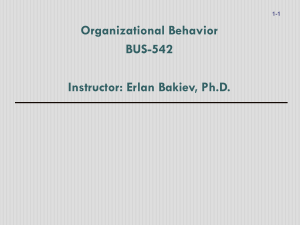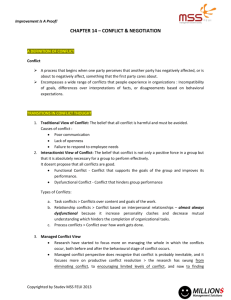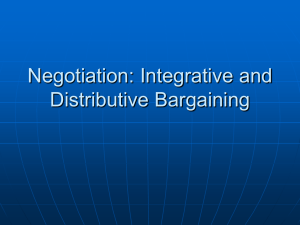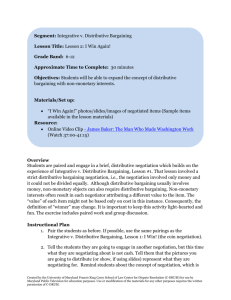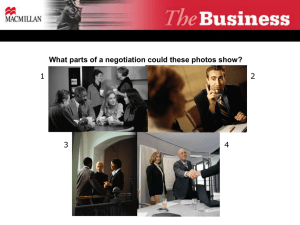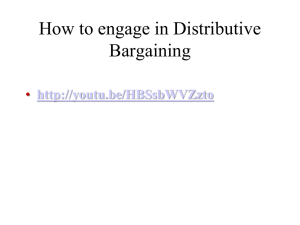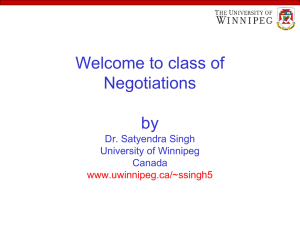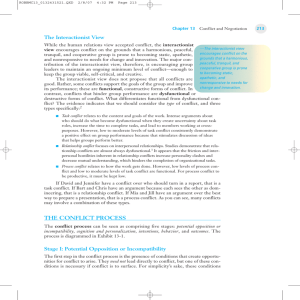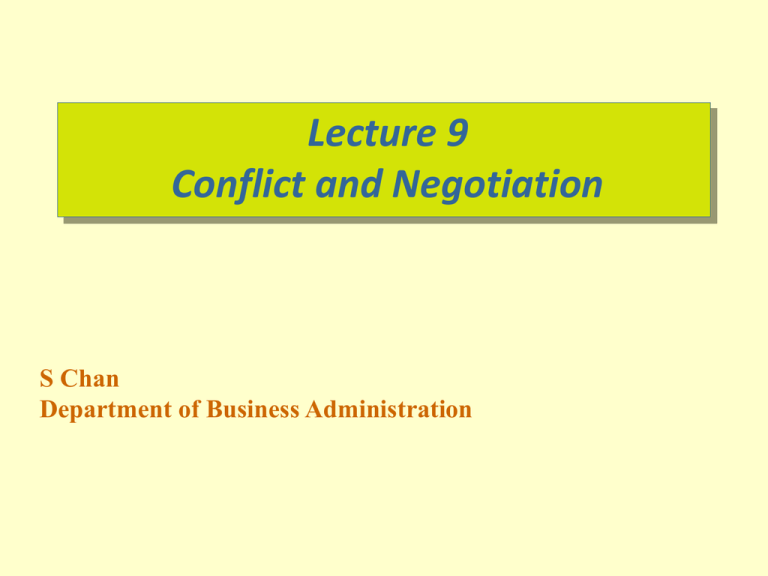
Lecture 9
Conflict and Negotiation
S Chan
Department of Business Administration
Definition of Conflict
A process that begins when one party perceives that
another party has negatively affected, or is about to
negatively affect, something that the first party cares
about
– That point in an ongoing activity when an interaction
“crosses over” to become an interparty conflict
Encompasses a wide range of conflicts that people
experience in organizations
– Incompatibility of goals
– Differences over interpretations of facts
– Disagreements based on behavioral expectations
Transitions in Conflict Thought
Traditional View of Conflict
– The belief that all conflict is harmful and must be avoided
– Prevalent view in the 1930s-1940s
Conflict resulted from:
– Poor communication
– Lack of openness and trust between people
– Failure to respond to employee needs
Continued Transitions in Conflict Thought
Human Relations View of Conflict
– The belief that conflict is a natural and inevitable outcome in
any group
– Human relations school advocated acceptance of conflict,
which may sometimes benefit a group’s performance
– Prevalent from the late 1940s through mid-1970s
Interactionist View of Conflict
– The belief that conflict is not only a positive force in a group
but that it is absolutely necessary for a group to perform
effectively
– Current view
Forms of Interactionist Conflict
Functional conflicts:
- Conflicts which are constructively support the goals of
the group and improve its performance
Dysfunctional conflicts:
-Conflicts that destructively hinder group performance or
involve personal attack.
Types of Interactionist Conflict
Task Conflict
– Conflicts over content and goals of the work
– Low-to-moderate levels of this type are
FUNCTIONAL
Relationship Conflict
– Conflict based on interpersonal relationships
– Almost always DYSFUNCTIONAL
Process Conflict
– Conflict over how work gets done
– Low levels of this type are FUNCTIONAL
The Conflict Process
We will focus on each step in a moment…
E X H I B I T 15-1
© 2009 Prentice-Hall Inc. All rights reserved.
Stage I: Potential Opposition or Incompatibility
Communication
– Semantic difficulties, misunderstandings, and “noise”
Structure
–
–
–
–
–
–
Size and specialization of jobs
Jurisdictional clarity/ambiguity
Member/goal incompatibility
Leadership styles (close or participative)
Reward systems (win-lose)
Dependence/interdependence of groups
Personal Variables
– Differing individual value systems
– Personality types
Stage II: Cognition and Personalization
Important stage for two reasons:
1. Conflict is defined
• Perceived Conflict
– Awareness by one or more parties of the existence of
conditions that create opportunities for conflict to arise
2. Emotions are expressed that have a strong impact on the
eventual outcome
• Felt Conflict
– Emotional involvement in a conflict creating anxiety,
tenseness, frustration, or hostility
Stage III: Intentions
Intentions
– Decisions to act in a given way
– Note: behavior does not always accurate reflect intent
Dimensions of conflict-handling intentions:
– Cooperativeness
• Attempting to satisfy
the other party’s
concerns
– Assertiveness
• Attempting to satisfy
one’s own concerns
Source: K. Thomas, “Conflict and Negotiation Processes in Organizations,” in M.D. Dunnette and L.M. Hough (eds.), Handbook of Industrial and
Organizational Psychology, 2nd ed., vol. 3 (Palo Alto, CA: Consulting Psychologists Press, 1992), p. 668. With permission.
E X H I B I T 15-2
Stage III: Intentions
Dimensions of conflict-handling intentions:
– Competing
• One seeks to satisfy his/her own interests, regardless of the impact
on other parties, one wins and the other losses.
– Collaborating
• Search for cooperation and a mutually beneficial outcome—WinWin solution. Party solve problems by clarifying differences rather
than by accommodating various points of view.
– Avoiding
• One to withdraw or suppress the conflicts. E.g. trying to ignore a
conflict and avoid others with whom you disagree.
– Accommodating
• One attempts to place the other conflicting party’s interest above
his/her own in order to maintain relationship. More self sacrificing
– Compromising
• Each party to a conflict seeks to give up something to results a
compromised outcome. No clear winner or loser.
Stage IV: Behavior
Conflict Management
–
The use of resolution and stimulation techniques to achieve the
desired level of conflict
Conflict- Resolution Techniques:
1.
Problem solving: Face to face meeting of the conflicting parties to
identifying the problems and resolving it through open discussions.
2.
Super-ordinate goals: Creating a shared goal that cannot be attained without
the cooperation of each of the conflicting parties
3.
Expansion of Resources: If conflict is caused by scarcity of resources,I.e.
money, promotion and opportunities– expansion of resources can create winwin solution.
4.
Avoidance: Withdrawal from or suppression of the conflict.
15-11
Stage IV: Behavior
Conflict- Resolution Techniques (con’t):
5.
Smoothing: Playing down differences while emphasizing common interests
between the conflicting parties
6.
Compromise: Each party to the conflicts gives up something of values.
7.
Authoritative command: Management uses its formal authority to resolve
the conflict then communicates its desires to the parties involved.
8.
Altering the human variable: Using behavioral change techniques such as
human relation training to alter attitudes and behaviors that cause conflict.
9.
Altering the structural variables: Changing the formal organization
structure and the interaction patterns of conflicting parties through job
redesign, transfer, creation of coordinating position..
Source: Based on S. P. Robbins, Managing Organizational Conflict: A Nontraditional Approach (Upper
Saddle River, NJ: Prentice Hall, 1974), pp. 59–89
Stage V: Outcomes
Functional
– Increased group
performance
– Improved quality of
decisions
– Stimulation of creativity
and innovation
– Encouragement of interest
and curiosity
– Provision of a medium for
problem-solving
– Creation of an environment
for self-evaluation and
change
Dysfunctional
– Development of discontent
– Reduced group
effectiveness
– Retarded communication
– Reduced group
cohesiveness
– Infighting among group
members overcomes group
goals
Creating Functional
Conflict
– Reward dissent and punish
conflict avoiders
Negotiation
Negotiation (Bargaining)
– A process in which two or more parties exchange goods or
services and attempt to agree on the exchange rate for them
Two general bargaining strategies:
– Distributive Bargaining
• Negotiation that seeks to divide up a fixed amount of resources;
a win-lose situation (labour-management negotiations over
wages)
– Integrative Bargaining
• Negotiation that seeks one or more settlements that can create
a win-win solution
Distributive versus Integrative Bargaining
Bargaining Characteristic
Distributive
Bargaining
Integrative Bargaining
Goal
Get all the pie you can
Expand the pie
Motivation
Win-Lose
Win-Win
Focus
Positions
Interests
Information Sharing
Low
High
Duration of Relationships
Short-Term
Long-Term
Source: Based on R. J. Lewicki and J. A. Litterer,
Negotiation (Homewood, IL: Irwin, 1985), p. 280.
Integrative
Yours Mine
Distributive
Yours Mine
Bargaining Tactics and the Bargaining Zone
Distributive Tactics
– Make an aggressive
first offer
– Reveal a deadline
Integrative Tactics
– Bargain in teams
– Put more issues on the table
– Don’t compromise
E X H I B I T 15-6
© 2009 Prentice-Hall Inc. All rights reserved.
15-16
The Negotiation Process
BATNA
– The Best Alternative
To a Negotiated
Agreement
– The lowest acceptable
value (outcome) to an
individual for a
negotiated agreement
The “Bottom Line”
for negotiations
E X H I B I T 15-7
Individual Differences in Negotiation Effectiveness
Personality Traits
– Extroverts and agreeable people weaker at distributive
negotiation – disagreeable introvert is best
– Intelligence is a weak indicator of effectiveness
Mood and Emotion
– Ability to show anger helps in distributive bargaining
– Positive moods and emotions help integrative bargaining
Gender
– Men and women negotiate the same way, but may
experience different outcomes
– Women and men take on gender stereotypes in negotiations:
tender and tough
– Women are less likely to negotiate
Global Implications
Conflict and Culture
– Japanese and U.S. managers view conflict differently
– U.S. managers more likely to use competing tactics while
Japanese managers are likely to use compromise and
avoidance
Cultural Differences in Negotiations
– Multiple cross-cultural studies on negotiation styles, for
instance:
• American negotiators are more likely than Japanese bargainers
to make a first offer
• North Americans use facts to persuade, Arabs use emotion, and
Russians used asserted ideals
• Brazilians say “no” more often than Americans or Japanese

